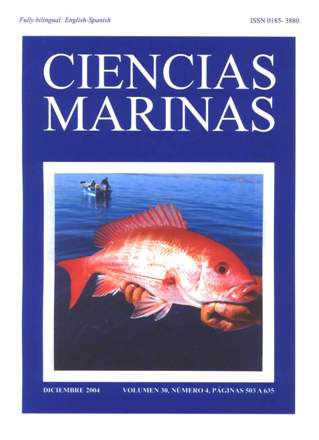Calibration of Sr/Ca and Mg/Ca paleothermometers in coral Porites sp. from San Benedicto Island, Revillagigedo Archipelago, Mexico
Main Article Content
Abstract
A better understanding of the global climate system depends on our ability to expand the limited instrumental records of sea surface temperature (SST) of tropical regions. The Sr/Ca and Mg/Ca ratios contained in the growth bands of corals have proved to be an accurate tool to reconstruct SST variability. In this study we show the calibration obtained from the seasonal geochemical measurement of the Sr/Ca and Mg/Ca molar ratios in the skeleton of coral of the genus Porites from San Benedicto Island, in the Revillagigedo Archipelago, and SST. The geochemical ratios measured (precision ±0.2%, 2σ) showed a high seasonal covariation closely related to the region's SST. The calibration equation calculated for the Sr/Ca–SST relation (n = 52) was Sr/Ca (mmol mol–1) = 10.467 (±0.067) – 0.0524 (±0.003) × SST (r2 = 0.894), and for the Mg/Ca?SST relation it was Mg/Ca (mmol mol–1) = 1.550 (±0.095) + 0.0956 (±0.0043) × STT (r2 = 0.906). When comparing the SST time series reconstructed from the Sr/Ca and Mg/Ca ratios with the mean SST of a spatial grid of 2º × 2º (longitude × latitude) that comprises San Benedicto Island, we found a high concordance between both temperatures, showing the robustness of the procedure. A drawback of this method is that no unique calibration exists for the Sr/Ca–SST and Mg/Ca–SST relations, and the different calibrations published generate discrepancies of up to 8ºC in the calculated temperature, regardless of whether the thermal sensitivity (i.e., the slope of the paleotemperature equation) of corals is similar. We therefore concluded that the Sr/Ca and Mg/Ca paleothermometers are highly reliable in this region of the Pacific Ocean, provided that a specific equation exists for the area under study.
Downloads
Article Details
This is an open access article distributed under a Creative Commons Attribution 4.0 License, which allows you to share and adapt the work, as long as you give appropriate credit to the original author(s) and the source, provide a link to the Creative Commons license, and indicate if changes were made. Figures, tables and other elements in the article are included in the article’s CC BY 4.0 license, unless otherwise indicated. The journal title is protected by copyrights and not subject to this license. Full license deed can be viewed here.

